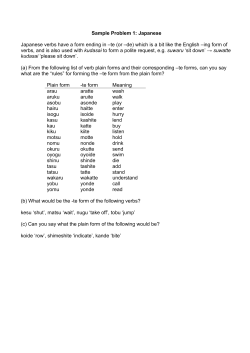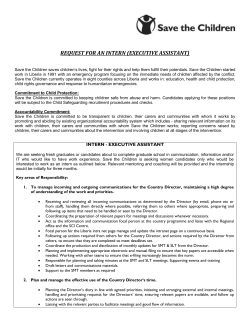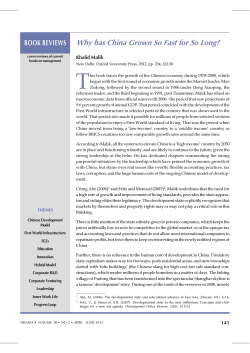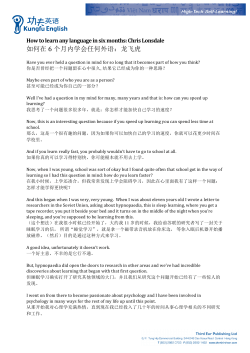
Refining Word Segmentation Using a Manually Aligned Corpus Xiaolin Wang Masao Utiyama
Refining Word Segmentation Using a Manually Aligned Corpus
for Statistical Machine Translation
Xiaolin Wang
Masao Utiyama
Andrew Finch
Eiichiro Sumita
National Institute of Information and Communications Technology
{xiaolin.wang,mutiyama,andrew.finch,eiichiro.sumita}@nict.go.jp
Abstract
Languages that have no explicit word delimiters often have to be segmented for statistical machine translation (SMT). This is
commonly performed by automated segmenters trained on manually annotated
corpora. However, the word segmentation
(WS) schemes of these annotated corpora
are handcrafted for general usage, and
may not be suitable for SMT. An analysis
was performed to test this hypothesis using a manually annotated word alignment
(WA) corpus for Chinese-English SMT.
An analysis revealed that 74.60% of the
sentences in the WA corpus if segmented
using an automated segmenter trained on
the Penn Chinese Treebank (CTB) will
contain conflicts with the gold WA annotations. We formulated an approach
based on word splitting with reference to
the annotated WA to alleviate these conflicts. Experimental results show that the
refined WS reduced word alignment error
rate by 6.82% and achieved the highest
BLEU improvement (0.63 on average) on
the Chinese-English open machine translation (OpenMT) corpora compared to related work.
1
Introduction
Word segmentation is a prerequisite for many
natural language processing (NLP) applications
on those languages that have no explicit space
between words, such as Arabic, Chinese and
Japanese. As the first processing step, WS affects
all successive steps, thus it has a large potential
impact on the final performance. For SMT, the
unsupervised WA, building translation models and
reordering models, and decoding are all based on
segmented words.
Automated word segmenters built through
supervised-learning methods, after decades of intensive research, have emerged as effective solutions to WS tasks and become widely used in
many NLP applications. For example, the Stanford word segmenter (Xue et al., 2002)1 which is
based on conditional random field (CRF) is employed to prepare the official corpus for NTCIR9 Chinese-English patent translation task (Goto et
al., 2011).
However, one problem with applying these
supervised-learning word segmenters to SMT is
that the WS scheme of annotating the training corpus may not be optimal for SMT. (Chang et al.,
2008) noticed that the words in CTB are often too
long for SMT. For example, a full Chinese personal name which consists of a family name and a
given name is always taken as a single word, but
its counterpart in English is usually two words.
Manually WA corpora are precious resources
for SMT research, but they used to be only available in small volumes due to the production cost.
For example, (Och and Ney, 2000) initially annotated 447 English-French sentence pairs, which
later became the test data set in ACL 2003 shared
task on word alignment (Mihalcea and Pedersen,
2003), and was used frequently thereafter (Liang
et al., 2006; DeNero and Klein, 2007; Haghighi et
al., 2009)
For Chinese and English, the shortage of manually WA corpora has recently been relieved
by the linguistic data consortium (LDC) 2
GALE Chinese-English word alignment and tagging training corpus (the GALE WA corpus)3 .
The corpus is considerably large, containing 4,735
documents, 18,507 sentence pairs, 620,189 Chinese tokens, 518,137 English words, and 421,763
1
http://nlp.stanford.edu/software/
segmenter.shtml
2
http://catalog.ldc.upenn.edu
3
Catalog numbers:
LDC2012T16, LDC2012T20,
LDC2012T24 and LDC2013T05.
1654
Proceedings of the 2014 Conference on Empirical Methods in Natural Language Processing (EMNLP), pages 1654–1664,
c
October 25-29, 2014, Doha, Qatar. 2014
Association for Computational Linguistics
alignment annotations. The corpus carries no Chinese WS annotation, and the WA annotation was
performed between Chinese characters and English words. The alignment identifies minimum
translation units and relations 4 , referred as atomic
blocks and atomic edges, respectively, in this paper. Figure 1 shows an example that contains six
atomic edges.
Visual inspection of the segmentation of an automatic segmenter with reference to a WA corpus revealed a number of inconsistencies. For example, consider the word “bao fa” in Figure 1.
Empirically we observed that this word is segmented as a single token by an automatic segmenter trained on the CTB, however, this segmentation differs with the alignment in the WA corpus, since its two components are aligned to two
different English words. Our hypothesis was that
the removal of these inconsistencies would benefit
machine translation performance (this is explained
further in Section 2.3), and we explored this idea
in this work.
This paper focuses on optimizing Chinese WS
for Chinese-English SMT, but both the research
method and the proposed solution are languageindependent. They can be applied to other language pairs.
The major contributions of this paper include,
• analyze the CTB WS scheme for ChineseEnglish SMT;
• propose a lexical word splitter to refine the
WS;
• achieve a BLEU improvement over a baseline
Stanford word segmenter, and a state-of-theart extension, on Chinese-English OpenMT
corpora.
The rest of this paper is organized as follows:
first, Section 2 analyzes WS using a WA corpus;
next, Section 3 proposes a lexical word splitter
to refine WS; then, Section 4 evaluates the proposed method on end-to-end SMT as well as word
segmentation and alignment; after that, Section 5
compares this work to related work; finally, Section 6 concludes this paper.
4
Guidelines for
ment(Version 4.0)
Chinese-English
Word
Align-
2 Analysis of a General-purpose
Automatic Word Segmenter
This section first briefly describes the GALE WA
corpus, then presents an analysis of the WS arising
from a CTB-standard word segmenter with reference to the segmentation of the atomic blocks in
the GALE WA corpus, finally the impact of the
findings on SMT is discussed.
2.1 GALE WA corpus
The GALE WA corpus was developed by the
LDC, and was used as training data in the DARPA
GALE global autonomous language exploitation
program 5 . The corpus incorporates linguistic
knowledge into word aligned text to help improve
automatic WA and translation quality. It employs two annotation schemes: alignment and tagging (Li et al., 2010). Alignment identifies minimum translation units and translation relations;
tagging adds contextual, syntactic and languagespecific features to the alignment annotation. For
example, the sample shown in Figure 1 carries tags
on both alignment edges and tokens.
The GALE WA corpus contains 18,057 manually word aligned Chinese and English parallel
sentences which are extracted from newswire and
web blogs. Table 1 presents the statistics on the
corpus. One third of the sentences are approximately newswire text, and the remainder consists
of web blogs.
2.2 Analysis of WS
In order to produce a Chinese word segmentation consistent with the CTB standard we used the
Stanford Chinese word segmenter with a model
trained on the CTB corpus. We will refer to this
as the ‘CTB segmenter’ in the rest of this paper.
The Chinese sentences in the GALE WA corpus were first segmented by the CTB segmenter,
and the predicted words were compared against
the atomic blocks with respect to the granularity of
segmentation. The analysis falls into the following
three categories, two of which may be potentially
harmful to SMT:
• Fully consistent: the word locates within the
block of one atomic alignment edge. For example, in Figure 2(a), the Chinese text has
5
https://catalog.ldc.upenn.edu/
LDC2012T16
1655
Figure 1: Example from the GALE WA corpus. Each line arrow represents an atomic edge, and each box
represents an atomic block. SEM (semantic), GIS (grammatically inferred semantic) and FUN (function)
are tags of edges. INC (not translated), TOI (to-infinitive) and DET (determiner) are tags of tokens.
Genre
Newswire
Web blog
Total
# Files
2,175
2,560
4,735
# Sentences†
6,218
11,839
18,057
# CN tokens
246,371
373,818
620,189
# EN tokens
205,281
312,856
518,137
# Alignment edges
164,033
257,730
421,763
Table 1: GALE WA corpus. † Sentences rejected by the annotators are excluded.
four atomic blocks; the CTB segmenter produces five words which all locate within the
blocks, so they are all small enough.
• Alignment inconsistent: the word aligns to
more than one atomic block, but the target
expression is contiguous, allowing for correct phrase pair extraction (Zens et al., 2002).
For example, in Figure 2(b), the characters in
the word “shuang fang”, which is produced
by the CTB segmenter, contains two atomic
blocks, but the span of the target “to both
side” is continuous, therefore the phrase pair
“shuang fang ||| to both sides” can be extracted.
• Alignment inconsistent and extraction hindered: the word aligned to more than one
atomic block, and the target expression is not
contiguous, which hinders correct phrase pair
extractions. For example, in Figure 2(c), the
word “zeng chan” has to be split in order to
match the target language.
Table 2 shows the statistics of the three categories of CTB WS on the GALE WA corpus.
90.74% of the words are fully consistent, while the
remaining 9.26% of the words have inconsistent
alignments. 74.60% of the sentences contain this
problem. The category with inconsistent alignment and extraction hindered only accounts for
0.46% of the words, affecting 9.06% of the sentences.
2.3 Impact of WS on SMT
The word alignment has a direct impact on the nature of both the translation model, and lexical reordering model in a phrase-base SMT system. The
words in last two categories are all longer than an
atomic block, which might lead to problems in the
word alignment in two ways:
• First, longer words tend to be more sparse in
the training corpus, thus the estimated distribution of their target phrases are less accurate.
• Second, the alignment from them to target
sides are one-to-many, which is much more
complicated and requires fertilized alignment
models such as IBM model 4 – 6 (Och and
Ney, 2000).
The words in the category of “fully consistent”
can be aligned using simple models, because the
alignment from them to the target side are one-toone or many-to-one, and simple alignment models
such as IBM model 1, IBM model 2 and HMM
model are sufficient (Och and Ney, 2000).
3 Refining the Word Segmentation
In the last subsection, it was shown that 74.60% of
parallel sentences were affected by issues related
to under-segmentation of the corpus. Our hypothesis is that if these words are split into pieces that
match English words, the accuracy of the unsupervised WA as well as the translation quality will be
improved. To achieve this, we adopt a splitting
1656
(a)
(b)
(c)
Figure 2: Examples of automated WS on manually WA corpus: (a) Fully consistent; (b) Alignment
inconsistent; (c) Alignment inconsistent and extraction hindered. The Chinese words separated by white
space are the output of the CTB segmenter. Arrows represent the alignment of atomic blocks. Note that
“shuang fang” and “zeng chan” are words produced by the CTB segmenter, but consist of two atomic
blocks.
Category
Fully consistent
Alignment inconsistent
Alignment inconsistent & extraction hindered
Sum of conflict ‡
Count
355,702
34,464
1,830
36,294
Word Ratio
90.74%
8.81%
0.46%
9.26%
Sentence Ratio
25.40%†
65.54%
9.06%
74.60%
Table 2: CTB WS on GALE WA corpus: † All words are fully consistent; ‡ Alignment inconsistent plus
alignment inconsistent & extraction hindered
strategy, based on a supervised learning approach,
to re-segment the corpus. This subsection first formalizes the task, and then presents the approach.
3.1 Word splitting task
The word splitting task is formalized as a sequence
labeling task as follows: each word (represented
by a sequence of characters x = x1 . . . xT where
T is the length of sample) produced by the CTB
segmenter is a sample, and a corresponding sequence of binary boundary labels y = y1 . . . yT
is the learning target,
1 if there is a split point
between ct and ct−1 ;
(1)
yt =
0 otherwise.
The sequence of boundary labels is derived
from the gold WA annotation as follows: for a
sequence of two atomic blocks, where the first
character of the second block is xt , then the la-
Figure 3: Samples of word splitting task
bel yt = 1. Figure 3 presents several samples extracted from the examples in Figure 2.
Each word sample may have no split point, one
split point or multiple split points, depending on
the gold WA annotation. Table 3 shows the statistics of the word splitting data set which is built
from the GALE manual WA corpus and the CTB
segmenter’s output, where 2000 randomly sampled sentences are taken as a held-out test set.
1657
Set
Train.
Test
# Sentences
16,057
2,000
# Samples
348,086
43,910
# Split points
32,337
3,929
# Split points per sample
0.0929
0.0895
Table 3: Data set for learning the word splitting
3.2 CRF approach
This paper employs a condition random field
(CRF) to solve this sequence labeling task (Lafferty et al., 2001). A linear-chain CRF defines the
conditional probability of y given x as,
T
1 XX
λk fk (yt−1 , yt , x, t)),
(
Zx
t=1 k
(2)
where Λ = {λ1 , . . .} are parameters, Zx is a perinput normalization that makes the probability of
all state sequences sum to one; fk (yt−1 , yt , x, t) is
a feature function which is often a binary-valued
sparse feature. The training of CRF model is to
maximize the likelihood of training data together
with a regularization penalty to avoid over-fitting
as (Peng et al., 2004; Peng and McCallum, 2006),
PΛ (y|x) =
X
X λ2
k
Λ∗ = argmax(
logPΛ (yi |xi ) −
2 ),
2δ
Λ
k
i
k
(3)
where (x,y) are training samples; the hyperparameter δk can be understood as the variance of the
prior distribution of λk . When predicting the labels of test samples, the CRF decoder searches for
the optimal label sequence y ∗ that maximizes the
conditional probability,
y∗ = argmax PΛ (y|x).
y
(4)
In (Chang et al., 2008) a method is proposed to
select an appropriate level of segmentation granularity (in practical terms, to encourage smaller
segments). We call their method “length tuner”.
The following artificial feature is introduced into
the learned CRF model:
½
1 if yt = +1
(5)
f0 (x, yt−1 , yt , 1) =
0 otherwise
The weight λ0 of this feature is set by hand to
bias the output of CRF model. By way of explanation, a very large positive λ0 will cause every
character to be segmented, or conversely a very
large negative λ0 will inhibit the output of segmentation boundaries. In their experiments, λ0 = 2
was used to force a CRF segmenter to adopt an intermediate granularity between character and the
CTB WS scheme. Compared to the length tuner,
our proposed method exploits lexical knowledge
about word splitting, and we will therefore refer to
it as the “lexical word splitter” or “lexical splitter”
for short.
3.3 Feature Set
The features fk (yt−1 , yt , x, t) we used include the
WS features from the Chinese Stanford word segmenter and a set of extended features described
below. The WS features are included because the
target split points may share some common characteristics with the boundaries in the CTB WS
scheme.
The extended features consists of four types –
named entities, word frequency, word length and
character-level unsupervised WA. For each type of
the feature, the value and value concatenated with
previous or current character are taken as sparse
features (see Table 4 for details). The real values of word frequency, word length and characterlevel unsupervised WA are converted into sparse
features due to the routine of CRF model.
The character-level unsupervised alignment
feature is inspired by the related works of unsupervised bilingual WS (Xu et al., 2008; Chung and
Gildea, 2009; Nguyen et al., 2010; Michael et al.,
2011). The idea is that the character-level WA can
approximately capture the counterpart English expression of each Chinese token, and source tokens
aligned to different target expressions should be
split into different words (see Figure 4 for an illustration).
The values of the character-level alignment features are obtained through building a dictionary.
First, unsupervised WA is performed on the SMT
training corpus where the Chinese sentences are
treated as sequences of characters; then, the Chinese sentences are segmented by CTB segmenter
and a dictionary of segmented words are built; finally, for each word in the dictionary, the relative
frequency of being split at a certain position is cal-
1658
Feature
NE
NE-C−1
NE-C0
Frequency
Freq.-C−1
Freq.-C0
Length
Len.-Position
Len.-C−1
Len.-C0
Char. Align.
C.A.-C−1
C.A.-C0
Definition
NE tag of current word
NE concatenated with previous character
NE concatenated with current character
Nearest integer of negative logarithm of word frequency
Frequency concatenated with previous character
Frequency concatenated with current character
Length of current word (1,2,3,4,5,6,7 or >7)
Length concatenated with the position
Length concatenated with previous character
Length concatenated with current character
Five-level relative frequency of being split
C.A. concatenated with previous character
C.A. concatenated with current character
Example
Geography:NE
Geo.-ding:NE-C−1
Geo.-mei:NE-C0
5† :Freq
5-ding:Freq-C−1
5-mei:Freq-C0
4:Len
4-2:Len-Pos
4-ding:Len-C−1
4-mei:Len-C0
0.4‡ :CA
0.4-ding:CA-C−1
0.4-mei:CA-C0
Table 4: Extended features used in the CRF model for word splitting. The example shows the features
used in the decision whether to split the Chinese word “la ding mei zhou” (Latin America, the first
four Chinese characters in Figure 4) after the second Chinese character. † Round(-log10 (0.00019)); ‡
Round(0.43 × 5 ) / 5
Figure 4: Illustration of character-level unsupervised alignment features. The dotted lines are
word boundaries suggested by the alignment.
ond, whether the accuracy of the unsupervised WA
during training SMT systems is improved; third,
whether the end-to-end translation quality is improved.
This section first describes the experimental
methodology, then presents the experimental results, and finally illustrates the operation of our
proposed method using a real example.
4.1 Experimental Methodology
4.1.1 Experimental Corpora
culated as,
fCA (w, i) =
ni
nw
(6)
where w is a word, i is a splitting position (from
1 to the length of w minus 1); ni is the number of
times the words as split at position i according to
the character-level alignment, that is, the character
before and after i are aligned to different English
expressions; nw is occurrence count of word w in
the training corpus.
4
Experiments
In the last section we found that 9.26% of words
produced by the CTB segmenter have the potential to cause problems for SMT, and propose a
lexical word splitter to address this issue through
segmentation refinement. This section contains
experiments designed to empirically evaluate the
proposed lexical word splitter in three aspects:
first, whether the WS accuracy is improved; sec-
The GALE manual WA corpus and the Chinese to
English corpus from the shared task of the NIST
open machine translation (OpenMT) 2006 evaluation 6 were employed as the experimental corpus
(Table 5).
The experimental corpus for WS was constructed by first segmenting 2000 held out sentences from the GALE manual WA corpus with
the Stanford segmenter, and then refining the segmentation with the gold alignment annotation. For
example, the gold segmentation for the examples
in Figure 2 is presented in Figure 5. Note that
this test corpus is intended to represent an oracle
segmentation for our proposed method, and serves
primarily to gauge the improvement of our method
over the baseline Stanford segmenter, relative to
an upper bound.
6
http://www.itl.nist.gov/iad/mig/
tests/mt/2006/
1659
4.1.3 Baseline Methods
Two Chinese WS methods were taken as the baseline methods in this paper. One method was the
CTB segmenter, that is, Stanford Chinese word
segmenter with the model trained on CTB corpus.
The other method was the length tuner in (Chang
et al., 2008), which added a constant into the confidence scores of a trained CRF word segmenter to
encourage it to output more word boundaries (see
Section 3.2 for details).
!
Figure 5: Examples of gold WS for evaluation
Set
Train.
Eval02
Eval03
Eval04
Eval05
Eval06
# sent. pairs
442,967
878†
919†
1,597†
1,082†
1,664†
# CN tokens
19,755,573
38,204
40,900
71,890
50,461
62,422
# EN tokens
13,444,927
105,944
113,970
207,279
138,952
189,059
4.1.4 Implementation and Parameter settings
Table 5: NIST Open machine translation 2006
Corpora. † Number of sentence samples which
contain one Chinese sentence and four English reference sentences.
The experimental corpus for unsupervised WA
was the union set of the NIST OpenMT training
set and the 2000 test sentence pairs from GALE
WA corpus. We removed the United Nations corpus from the NIST OpenMT constraint training resources because it is out of domain.
The main result of this paper is the evaluation
of the end-to-end performance of an SMT system. The experimental corpus for this task was
the NIST OpenMT corpus. The data set of the
NIST evaluation 2002 was used as a development
set for MERT tuning (Och, 2003), and the remaining data sets of the NIST evaluation from 2003 to
2006 were used as test sets. The English sentences
were tokenized by Stanford toolkit 7 and converted
to lowercase.
4.1.2 Evaluation
The performance of WS was measured by precision, recall and F1 of gold words (Sproat and
Emerson, 2003),
The performance of unsupervised WA in the
SMT training procedure was measured through
alignment error rate (AER)(Och and Ney, 2000;
Liang et al., 2006). Sure alignment edges and
possible alignment edges were not distinguished
in this paper as no such tags are found in GALE
manual WA corpus.
The performance of SMT was measured using
BLEU (Papineni et al., 2002).
7
http://nlp.stanford.edu/software/
corenlp.shtml
The proposed lexical word splitter was implemented on the CRF model toolkit released with
the Stanford segmenter (Tseng et al., 2005). The
regularity parameters δk are set to be 3, the same
as the Stanford segmenter, because no significant
performance improvements were observed by tuning that parameter.
To extract features for the word splitter, the
Stanford named entity recognizer (Finkel et al.,
2005)8 was employed to obtain the tags of named
entities. Word frequencies were caculated from
the source side of SMT training corpus. The
character-level unsupervised alignment was conducted using GIZA++ (Och and Ney, 2003)9 .
The length tuner reused the CRF model of CTB
segmenter. The parameter λ0 was tuned through
the grid search in (Chang et al., 2008), that is, observing the BLEU score on the SMT development
set varing from λ0 = 0 to λ0 = 32. The grid
search showed that λ0 = 2 was optimal, agreeing
with the value in (Chang et al., 2008).
Moses (Koehn et al., 2007)10 , a state-of-the-art
phrase-based SMT system, was employed to perform end-to-end SMT experiments. GIZA++ was
employed to perform unsupervised WA.
4.2 Experimental Results
4.2.1 Word Segmentation
The WS performance of CTB segmenter, length
tuner and the proposed lexical splitter are presented in Table 6. The proposed method achieves
the highest scores on all the criterion of F1 , precision and recall. The length tuner outperforms the
CTB segmenter in terms of recall, but with lower
precision.
8
http://nlp.stanford.edu/software/
CRF-NER.shtml
9
http://www.statmt.org/moses/giza/
GIZA++.html
10
http://www.statmt.org/moses/
1660
WS
CTB segmenter
Length tuner
Lexical splitter
F1
0.878
0.873
0.915
Prec.
0.917
0.894
0.922
Recall
0.842
0.852
0.908
got the right translation, while the length tuner did
not split it. The second is “rong jing”(booming or
prosperity), the length tuner split this word, which
resulted in wrong translations, while the lexical
splitter avoided this mistake.
Table 6: Performance of WS
WS
CTB segmenter
Length tuner
Lexical splitter
AER
0.425
0.417
0.396
Prec.
0.622
0.642
0.674
5 Comparison to Related Work
Recall
0.534
0.535
0.547
Table 7: Performance of unsupervised WA using
different WS strategies
4.2.2 Word Alignment
The WA performance of the CTB segmenter,
length tuner and the proposed lexical spliter is presented in Table 7. Both lexical splitter and length
tuner outperform the CTB segmenter, indicating
the splitting words into smaller pieces can improve
the accuracy of unsupervised WA. This result supports the finding in (Chang et al., 2008) that the
segment size from CTB WS is too large for SMT.
In addition, the proposed lexical splitter significantly outperforms the length tuner.
4.2.3 Machine Translation
The end-to-end SMT performance of CTB segmenter, length tuner and the proposed lexical
spliter are presented in Table 8. Each experiment
was performed three times, and the average BLEU
and standard derivation were calculated, because
there is randomness in the results from MERT.
The proposed lexical splitter outperformed the two
baselines on all the test sets, and achieves an
average improvement of 0.63 BLEU percentage
points, indicating that the proposed method can
effectively improve the translation quality. The
length tuner also outperforms the CTB segmenter,
but the average improvement is 0.15 BLEU percentage points, much less than the proposed methods.
4.3 Analysis
Figure 6 presents an example from the test corpus, which demonstrates how the proposed lexical
splitter splits words more accurately than the baseline length tuner method. Two words in the segmentation result of the CTB segmenter are worthy of attention. The first one is “yang nian”(the
year of goat), the lexical splitter split this word and
The most similar work in the literature to the proposed method is the the length tuner method proposed by (Chang et al., 2008). This method also
encourages the generation of more words during
segmentation by using a single parameter that can
be use to control segment length. Our method differs from theirs in that it is able to acquire vocabulary knowledge from word alignments that can be
used to more accurately split words into segments
suitable for machine translation.
There is large volume of research using bilingual unsupervised and semi-supervised WS to address the problem of optimizing WS for SMT (Xu
et al., 2008; Chung and Gildea, 2009; Nguyen et
al., 2010; Michael et al., 2011). The main difference with our approach is that they use automatic
WA results, most often obtained using the same
tools as are used in training SMT systems. One of
the main problems of using unsupervised WA is
that it is noisy, and therefore, employing iterative
optimization methods to refine the results of unsupervised WA is a key issue in their research, for
example boosting (Ma and Way, 2009; Michael et
al., 2011), expectation maximization (Chung and
Gildea, 2009), Bayesian sampling (Xu et al., 2008;
Nguyen et al., 2010), or heuristic search (Zhao et
al., 2013). Nevertheless, noisy WA makes both
analyzing WS and improving SMT quality quite
hard. In contrast, by using manual WA, we can
clearly analyze the segmentation problems (Section 2), and train supervised models to solve the
problem (Section 3).
As far as we are aware, among related work
on WS, our method achieves the highest BLEU
improvement relative to the start-of-the-art WS –
the Stanford Chinese word segmenter – on the
Chinese-English OpenMT corpora. The methods proposed in (Ma and Way, 2009; Chung
and Gildea, 2009) fail to outperform the Stanford Chinese word segmenter on Chinese-English
OpenMT corpora. The length tuner method proposed in (Chang et al., 2008) is less effective to
ours according to the experimental results in this
paper.
1661
WS
CTB segmenter
Length tuner
Lexical splitter
eval03
31.89 ± 0.09
32.06 ± 0.07
32.55 ± 0.18
eval04
32.73 ± 0.19
32.74 ± 0.10
32.94 ± 0.11
eval05
31.03 ± 0.16
31.34 ± 0.11
31.87 ± 0.15
eval06
31.38 ± 0.23
31.50 ± 0.11
32.17 ± 0.35
improve
0.15 ± 0.12
0.63 ± 0.29
Table 8: Performance (BLEU) of SMT
(a)
(b)
(c)
(d)
Figure 6: Example of SMT from test sets. (a) source; (b) CTB segmenter; (c) length tuner; (d) lexical
splitter. The four gold references are: “ethnic chinese in asia celebrate year of goat and hope for economic
prosperity in new year”, “ asian chinese celebrate the arrival of the year of sheep and wish a prosperous
new year”, “ asian chinese happily welcome the year of goat , expecting economic prosperity in new
year”,“asian chinese happily welcomed year of the goat , praying for prosperity in the new year”
6
Conclusion
This paper is concerned with the role of word
segmentation in Chinese-to-English SMT. We explored the use of a manually annotated word alignment corpus to refine word segmentation for machine translation. Based on an initial finding that
74.60% of running sentences in the WA corpus
have segmentation inconsistent with a gold WA
annotation, we proposed a supervised lexical resegmentation model to modify the WS in order to
relieve these issues.
Our main experimental results show that the
proposed approach is capable of improving both
alignment quality and end-to-end translation qual-
ity. The proposed method achieved the highest
BLEU score relative to a number of respectable
baseline systems that included the Stanford word
segmenter, and an improved Stanford word segmenter that could be tuned for segment length. No
language-specific techniques other than a manually aligned corpus were employed in this paper,
thus the approach can applied to other SMT language pairs that require WS.
In the future, we plan to explore combining
multiple source words which are aligned to the
same target words. This is the symmetric topic
of the post word splitting which is studied in this
paper. The effect of this word combination oper-
1662
ation on SMT is non-trivial. On one hand, it can
reduce the ambiguity in the source side. On the
other hand, it may cause sparseness problems.
Acknowledgements
John Lafferty, Andrew McCallum, and Fernando CN
Pereira. 2001. Conditional random fields: Probabilistic models for segmenting and labeling sequence data. In Proceedings of the 18th International Conference on Machine Learning, pages 282–
289. Association for Computing Machinery.
We thank the three reviewers for their valuable
comments. We also thank the Stanford natural language processing group for releasing the source
codes of their word segmenter.
Xuansong Li, Niyu Ge, Stephen Grimes, Stephanie
Strassel, and Kazuaki Maeda. 2010. Enriching
word alignment with linguistic tags. In LREC, pages
2189–2195.
References
Pi-Chuan Chang, Michel Galley, and Christopher D
Manning. 2008. Optimizing Chinese word segmentation for machine translation performance. In Proceedings of the 3rd Workshop on Statistical Machine
Translation, pages 224–232. Association for Computational Linguistics.
Tagyoung Chung and Daniel Gildea. 2009. Unsupervised tokenization for machine translation. In
Proceedings of the 2009 Conference on Empirical
Methods in Natural Language Processing: Volume
2-Volume 2, pages 718–726. Association for Computational Linguistics.
John DeNero and Dan Klein. 2007. Tailoring word
alignments to syntactic machine translation. In ACL,
volume 45, page 17.
Jenny Rose Finkel, Trond Grenager, and Christopher
Manning. 2005. Incorporating non-local information into information extraction systems by gibbs
sampling. In Proceedings of the 43rd Annual Meeting on Association for Computational Linguistics,
pages 363–370. Association for Computational Linguistics.
Isao Goto, Bin Lu, Ka Po Chow, Eiichiro Sumita, and
Benjamin K Tsou. 2011. Overview of the patent
machine translation task at the NTCIR-9 workshop.
In Proceedings of NTCIR, volume 9, pages 559–578.
Aria Haghighi, John Blitzer, John DeNero, and Dan
Klein. 2009. Better word alignments with supervised itg models. In Proceedings of the Joint
Conference of the 47th Annual Meeting of the ACL
and the 4th International Joint Conference on Natural Language Processing of the AFNLP: Volume 2Volume 2, pages 923–931. Association for Computational Linguistics.
Philipp Koehn, Hieu Hoang, Alexandra Birch, Chris
Callison-Burch, Marcello Federico, Nicola Bertoldi,
Brooke Cowan, Wade Shen, Christine Moran,
Richard Zens, et al. 2007. Moses: open source
toolkit for statistical machine translation. In Proceedings of the 45th Annual Meeting of the ACL
on Interactive Poster and Demonstration Sessions,
pages 177–180. Association for Computational Linguistics.
Percy Liang, Ben Taskar, and Dan Klein. 2006. Alignment by agreement. In Proceedings of the main
conference on Human Language Technology Conference of the North American Chapter of the Association of Computational Linguistics, pages 104–
111. Association for Computational Linguistics.
Yanjun Ma and Andy Way. 2009. Bilingually motivated domain-adapted word segmentation for statistical machine translation. In Proceedings of the 12th
Conference of the European Chapter of the Association for Computational Linguistics, pages 549–557.
Association for Computational Linguistics.
Paul Michael, Andrew Finch, and Eiichiro Sumita.
2011. Integration of multiple bilingually-trained
segmentation schemes into statistical machine translation. IEICE transactions on information and systems, 94(3):690–697.
Rada Mihalcea and Ted Pedersen. 2003. An evaluation
exercise for word alignment. In Rada Mihalcea and
Ted Pedersen, editors, HLT-NAACL 2003 Workshop:
Building and Using Parallel Texts: Data Driven Machine Translation and Beyond, pages 1–10, Edmonton, Alberta, Canada, May 31. Association for Computational Linguistics.
ThuyLinh Nguyen, Stephan Vogel, and Noah A Smith.
2010. Nonparametric word segmentation for machine translation. In Proceedings of the 23rd International Conference on Computational Linguistics,
pages 815–823. Association for Computational Linguistics.
Franz Josef Och and Hermann Ney. 2000. A comparison of alignment models for statistical machine
translation. In Proceedings of the 18th conference on Computational linguistics-Volume 2, pages
1086–1090. Association for Computational Linguistics.
Franz Josef Och and Hermann Ney. 2003. A Systematic Comparison of Various Statistical Alignment
Models. Computational Linguistics, 29(1):19–51.
Franz Josef Och. 2003. Minimum error rate training
in statistical machine translation. In Proceedings of
the 41st Annual Meeting on Association for Computational Linguistics-Volume 1, pages 160–167. Association for Computational Linguistics.
1663
Kishore Papineni, Salim Roukos, Todd Ward, and WeiJing Zhu. 2002. BLEU: a method for automatic
evaluation of machine translation. In Proceedings
of the 40th Annual Meeting on Association for Computational Linguistics, pages 311–318. Association
for Computational Linguistics.
Fuchun Peng and Andrew McCallum. 2006. Information extraction from research papers using conditional random fields. Information Processing &
Management, 42(4):963–979.
Fuchun Peng, Fangfang Feng, and Andrew McCallum.
2004. Chinese segmentation and new word detection using conditional random fields. Computer Science Department Faculty Publication Series.
Richard Sproat and Thomas Emerson. 2003. The
first international chinese word segmentation bakeoff. In Proceedings of the second SIGHAN workshop on Chinese language processing-Volume 17,
pages 133–143. Association for Computational Linguistics.
Huihsin Tseng, Pichuan Chang, Galen Andrew, Daniel
Jurafsky, and Christopher Manning. 2005. A conditional random field word segmenter for SIGHAN
Bakeoff 2005. In Proceedings of the 4th SIGHAN
Workshop on Chinese Language Processing, volume
171. Jeju Island, Korea.
Jia Xu, Jianfeng Gao, Kristina Toutanova, and Hermann Ney.
2008.
Bayesian semi-supervised
Chinese word segmentation for statistical machine
translation. In Proceedings of the 22nd International Conference on Computational LinguisticsVolume 1, pages 1017–1024. Association for Computational Linguistics.
Nianwen Xue, Fu-Dong Chiou, and Martha Palmer.
2002. Building a large-scale annotated chinese corpus. In Proceedings of the 19th international conference on Computational linguistics-Volume 1, pages
1–8. Association for Computational Linguistics.
Richard Zens, Franz Josef Och, and Hermann Ney.
2002. Phrase-based statistical machine translation.
In Advances in Artificial Intelligence, pages 18–32.
Springer.
Hai Zhao, Masao Utiyama, Eiichro Sumita, and BaoLiang Lu. 2013. An empirical study on word segmentation for chinese machine translation. A. Gelbukh (Ed.): CICLing 2013, Part II, LNCS 7817,
pages 248–263.
1664
© Copyright 2025









